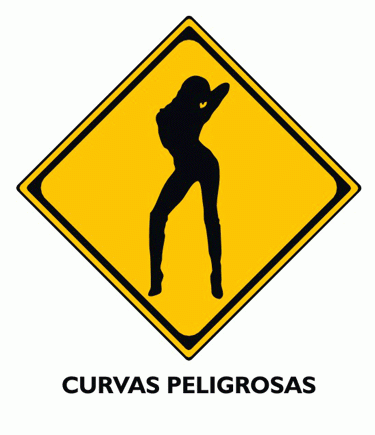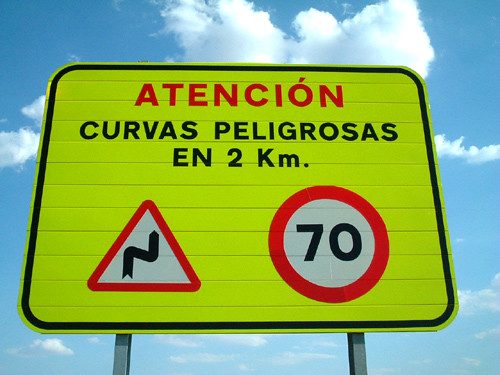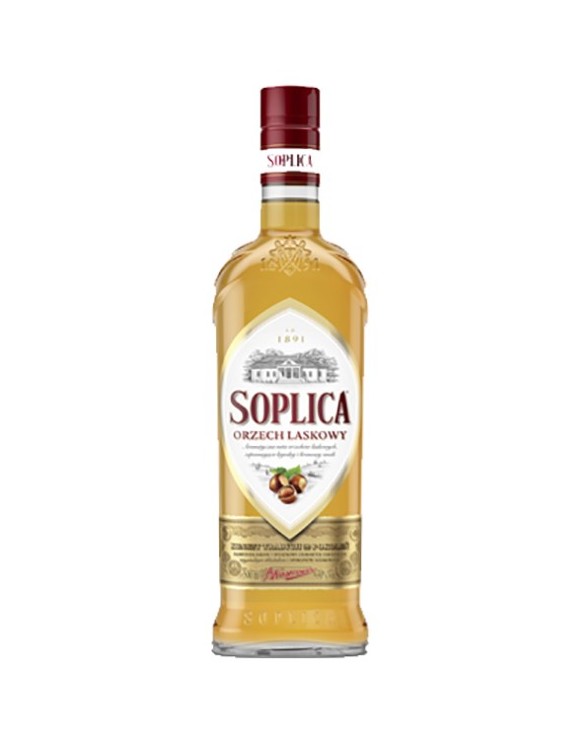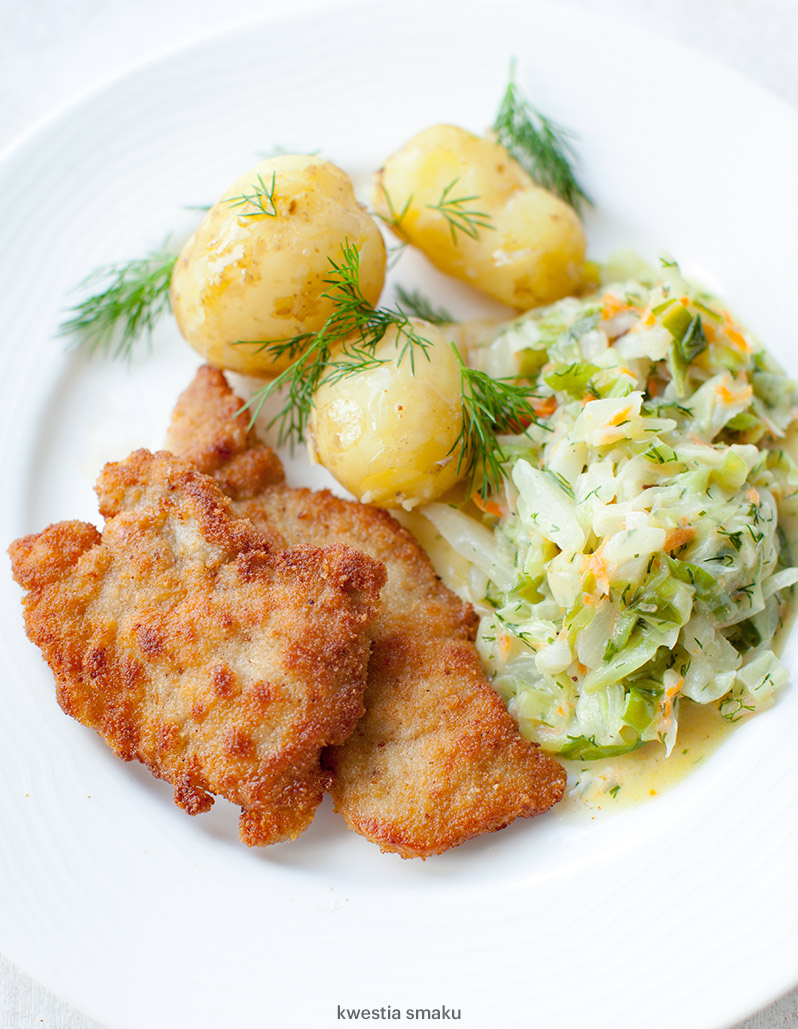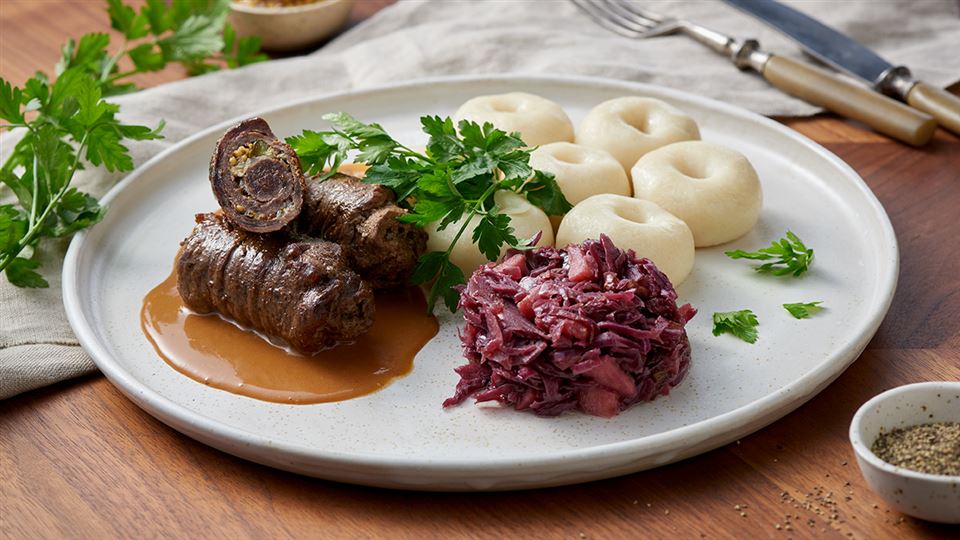
Leather handicraft straight from the workshop on four wheels
Wandering through Iberian lands
(Almost) everything you need to know about Poland!
15/08/2021 4:55 PM
Some time ago I went to Poland (the beginning of June 2021) but unfortunately I didn’t have time to translate this article until now so I hope you can forive me and enjoy its content. I travelled on buisness with a lot of my Spanish collegues and I decided to prepare a short article for them (and for you) that will prepare them for a visit to our beautiful country. Today I will tell you the words to be careful with because they mean something completely different in Spanish than in Polish; about customs that are worth paying attention to and that often find a strange reaction among foreigners; and about Polish cuisine and dishes and products that you cannot not try while in Poland.
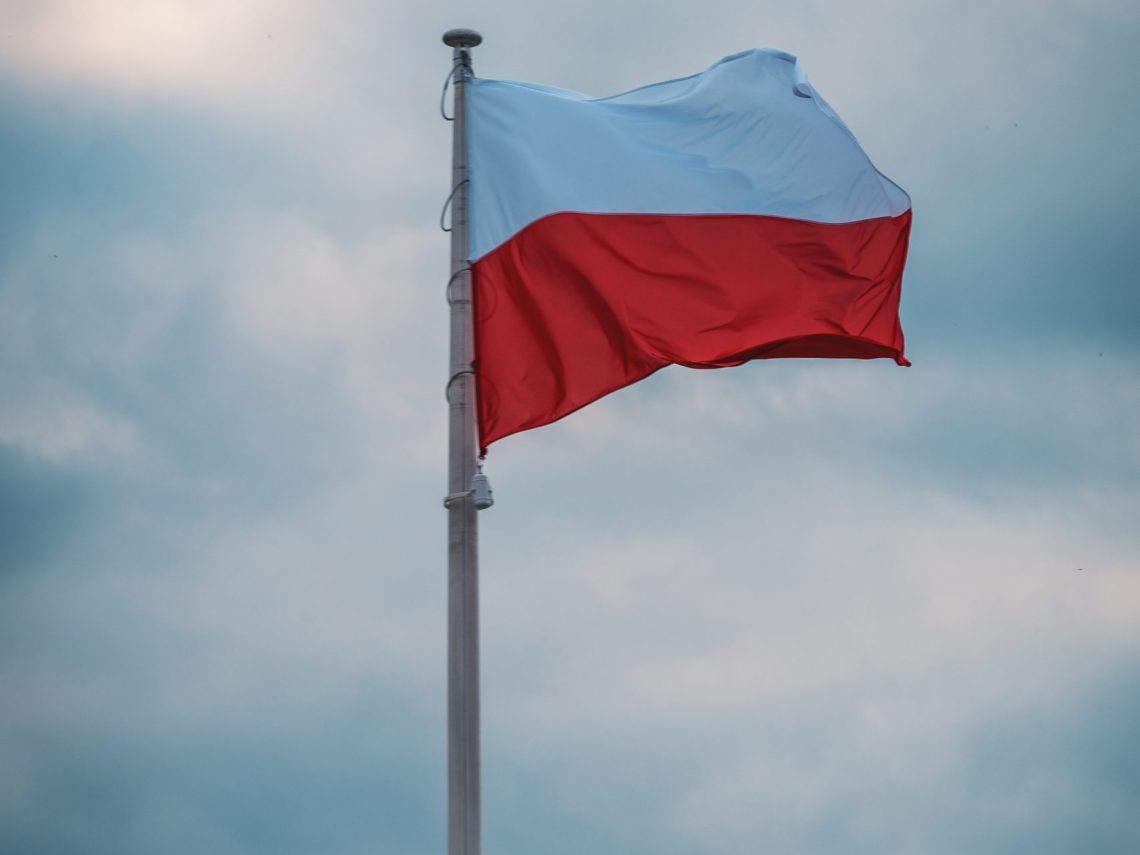
FALSE FRIENDS
DROGA and KURWA
These are the two most controversial words. "Droga" in Polish means road, while in Spanish it is totally something else (...drug). So if you see a sign or a road sign with the word DROGA somewhere, it does not mean that it is a point of sale for heroin or cocaine.
The word "KURWA" is even more fun: in Spanish, written with "C" ("curva") means „a curve” or „a turn”, while in Polish it is a very vulgar term and generally means "a whore", but it is also used frequently while speaking, like a comma, comparable to the Spanish "joder” or English „fuck", but it’s just much stronger. For example, if you accidentaly said „joder” while talking to your grandma in Spain, probably nothing would happen, while saying „kurwa” in the presence of your grandmother in Poland is a very big deal. In Spain it always makes me laugh when I see the sign "curvas peligrosas" – which obviously means „dangerous turns / curves on the road” but my mind always interprets it a little differently.
CENA, KAWA, KURA
"Cena" in Polish means "price". Spanish "cava" is a sparkling wine similiar to champagne, and „kawa” in Polish is of course a completely different drink, drunk all over the world, it is made from roasted and ground coffee beans - it is simply a Spanish "café" and English „coffee”.

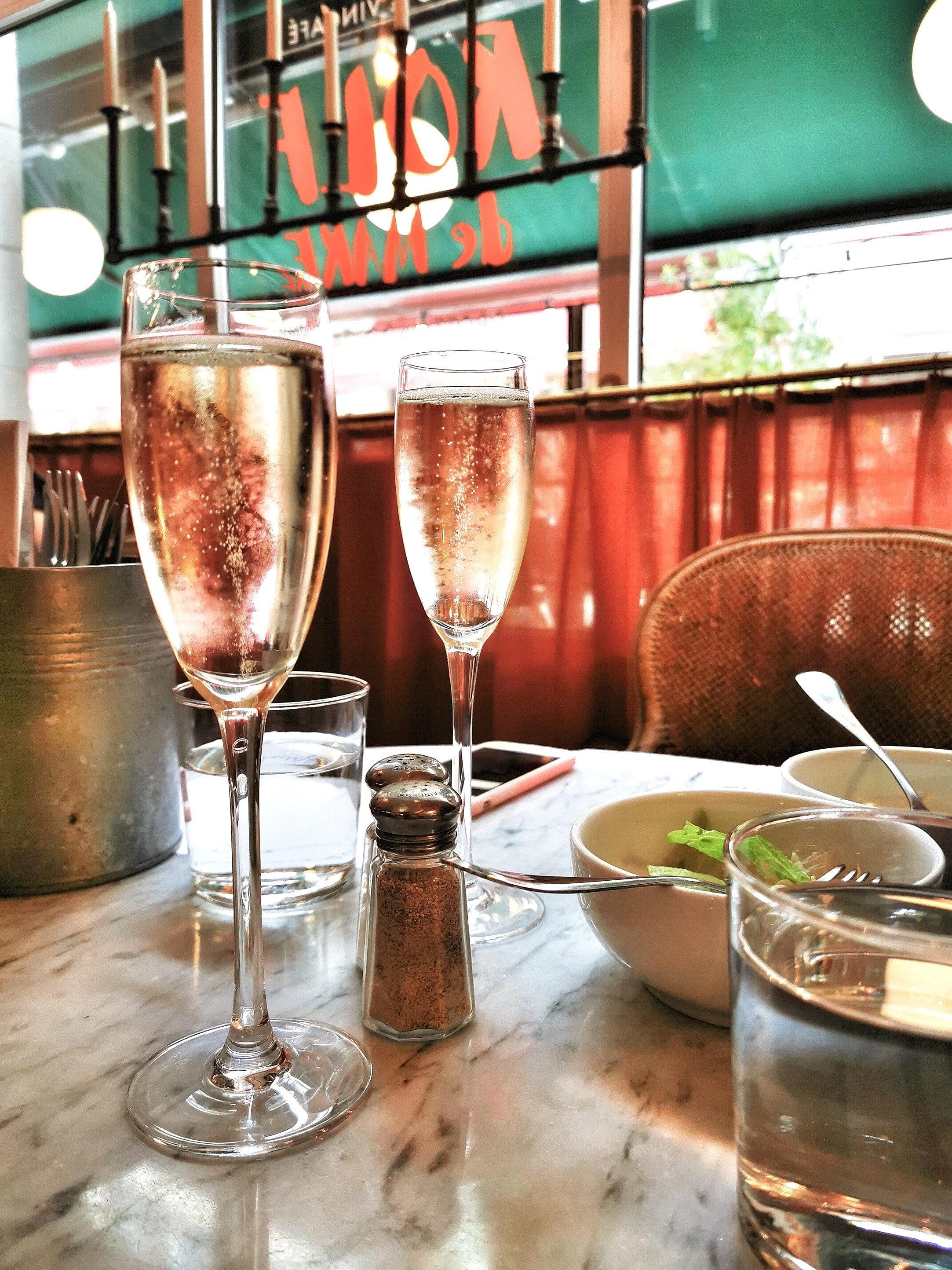
Remember also that when a Spaniard says "cura" he is referring to a priest, while at KFC he will eat a Polish "kura" - yes, it is simply a „pollo” or „chicken”. Not to be confused with the word „kurwa” described above ...


SER, PAN, RANA, JAJA and others
"Pan" is the Polish word for "sir", "pani" is "madam" while in Spanish its „bread” - a must in almost every meal. In Poland, we will make a sandwich of „ser” because Polish “ser” is English „cheese” and Spanish “queso”. In Spain, however, "ser" is a verb which means „to be”. The Spanish "rana" is simply a small jumping amphibian („a frog”), the Polish "rana" is a wound. When talking to our Spanish friends on WhatsApp, we will laugh instead of "ha ha" (as in Polish) - "jaja" which in Polish means "eggs". The Spanish word "pies" („feet”) in Polish means the men’ best friend – "a dog". In turn, "boda" (Spanish for „wedding”) can be confused with the Polish word "woda" („water”) as they are pronounced very similarly. "Debil" (in Spanish spelled with an accent means "weak") in Polish it’s "an idiot” or „mooron”

Aside from the false friends, I would also like to draw your attention to some useful phrases that are worth learning before coming to Poland because, like many nations, we really like when someone speaks to us in our language.
Dzień dobry! (Good Morning)
Dobry wieczór! (Good evening)
Dobranoc! (Good night)
Dzięki (Thanks)
Na zdrowie! (Cheers!)
Gdzie jest ...? (Where is…?)
Przepraszam (Excuse me, I am sorry, with permission)
Proszę (please, here you go ...)
Tak (Yes)
Nie (no)
What is the most surprising thing for foreigners who come to Poland?
First of all, the habit of taking off our shoes when we visit someone. I have never encountered this in Spain, but in Poland it is the norm. If we visit someone at home, we remove our shoes when entering the apartment or home. Sometimes the host will have slippers ready for us, which is unthinkable for many visitors to our beautiful country. In addition to slippers for guests, a typical Polish house has a trash can under the kitchen sink and a plastic bag full of other plastic bags hidden somewhere in the kitchen (because they will surely come in handy one day). When you visit someone, bring a small gift: flowers are old-fashioned, but a bottle of wine or chocolates or a homemade cake are still popular. Remember that in Poland we greet each other by shaking hands, especially with strangers. A kiss on the cheek is typical of very good friends, it is hardly ever seen between men.
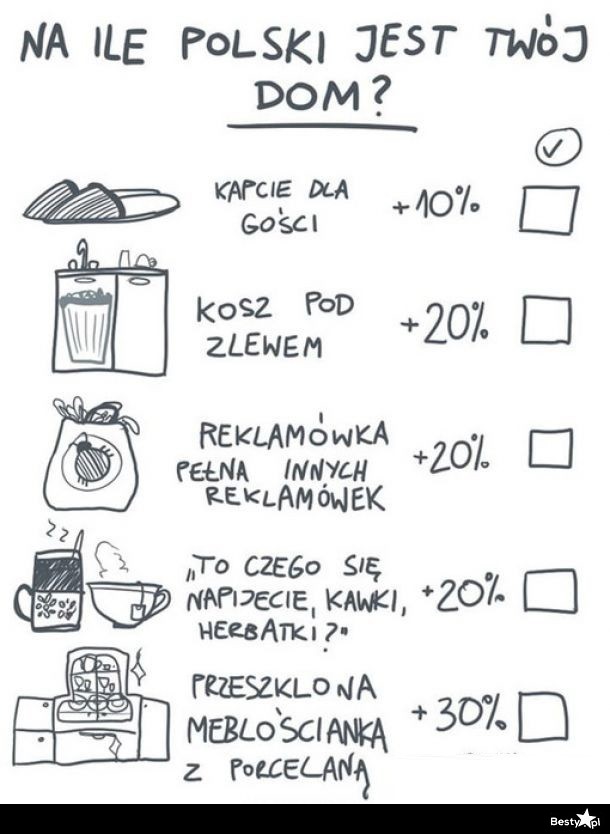
ALCOHOL
We Poles have a reputation of drunks and we have to accept it because many of our compatriots contributed to the formation of this opinion. Now times have changed a bit and I think we drink less but still a lot. Alcohol in Poland is cheap and widely available, especially beer, which can be found cold in almost all local grocery stores. Drinking is our national sport.

BEER
When it comes to beer, in Poland we have an incredible selection of brands, but what is more surprising, especially for those who come from Mediterranean countries, is not a great selection but… the size! Beer with a capacity of 0.33 l and 0.25 l is almost not sold in Poland is a phenomenon at all. When simply ordering "beer", we asked for 0.5 l. If we decide to have a draft beer, we can ask for a small one, with a capacity of 0.33l, but hardly anyone decides to choose it. You will realise while shopping that cans and bottles usually start from 0.5L. In Poland, we pay in złoty (zloty), 1 EUR is currently 4.49 PLN. The price of beer ranges between 0.70 EUR and 1 EUR for 0.5 l (of course we can find cheaper brands and stores, as well as frequent promotions). Remember that when buying beer in a glass bottle, a deposit is added to the price; if we return the bottle, we will give you back a few pennies (grosze). In some large supermarkets, we have machines for returning empty glass bottles. In most cases, we return them directly at the shops counter. The price of beer in a bar ranges from EUR 1 to EUR 4, depending on the location.

When it comes to typical Polish beer, there are three main breweries: Żywiec, Tyskie and Okocim, but apart from them hundreds of smallers ones which makes the choice huge. Personally, my favorites are Kasztelan and Perła, but each brewery produces several different types, often the offer includes pilsner, lager, dark, flavored (eg honey) or strong beer. It is also a surprise that in Poland, especially in winter, you drink hot beer (with spices such as cloves, ginger or cinnamon, with a slice of orange and honey) and "beer with juice", that is, with raspberry syrup (an option often chosen by women) or in some places you will also find ginger syrup.
WINE OR VODKA
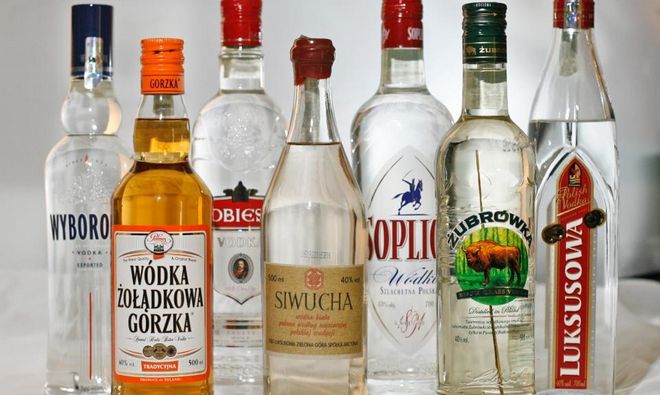
In Poland, wine is very little drunk, especially if we compare consumption with Spain or Portugal, it is not our favorite alcohol. The available wines are imported from the Iberian Peninsula, but also from Italy, Germany, France, Chile and California. Generally, the choice is the same as in other European countries. However, beware of wine-like drinks, which are also called wine; They cost € 1 or € 2 a bottle, but trust me, they have nothing to do with similarly priced wines in your country. These are really terrible junk drinks that teens choose when they want to get drunk quickly and spend little money. The hangover that accompanies the so-called Polish jabol is legendary and hard to fight. I must admit, however, that the names of these "wines" are quite funny - you will find, among others, "Sperma Szatana" (Sperm of Satan), „Leśny Dzban” (Jug of the forest - wine in a paper bag) , "Granat" (pomegranate) or the incredibly famous "Komandos" (Commando) on the shelves.
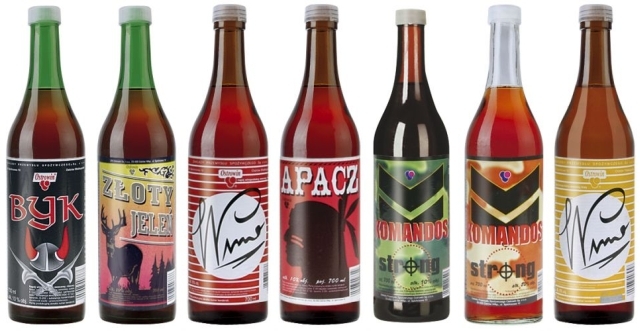
While in Poland, it is impossible not to try vodka. We have a selection of vodkas made with potatoes or cereal. "Wyborowa" is a particularly important brand, but the best known is Żubrówka. Żubrówka is not pure vodka, it is flavored vodka made from rye. You will find a blade of grass in the original bottle. You have to taste it with apple juice. We drink vodka in cocktails but also as shots and it should always be very well frozen. The best appetizers with vodka are sour cucumbers (pickles), herring, a slice of bread with lard or meat jelly (there is probably nothing more popular from the time of the People's Republic of Poland (PRL) than the "binoculars with jellyfish" („lorneta z meduzą”): 50 ml of vodka with pork jelly). Remember to avoid mixing alcoholic beverages, and if you decide to drink several types of alcohol in one night, start with the weakest and end with the strongest (so it is easier to avoid a hangover). If drinking straight vodka in shots is not for you, we also have flavored vodka. I especially recommend the walnut vodka, which is drunk with milk and tastes like the best dessert.
with vodka are sour cucumbers (pickles), herring, a slice of bread with lard or meat jelly (there is probably nothing more popular from the time of the People's Republic of Poland (PRL) than the "binoculars with jellyfish" („lorneta z meduzą”): 50 ml of vodka with pork jelly). Remember to avoid mixing alcoholic beverages, and if you decide to drink several types of alcohol in one night, start with the weakest and end with the strongest (so it is easier to avoid a hangover). If drinking straight vodka in shots is not for you, we also have flavored vodka. I especially recommend the walnut vodka, which is drunk with milk and tastes like the best dessert.
POLISH CUISINE
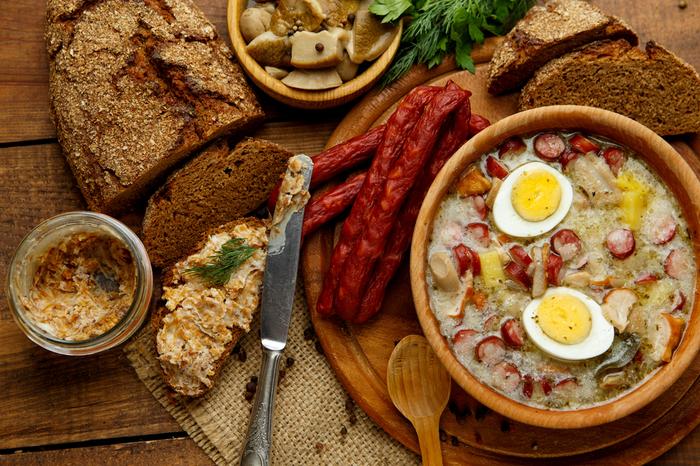
Polish cuisine is, in my opinion, one of the best in Europe, although in general it is not the healthiest. It is based on meat. Do not be surprised by the fact that Polish sausage is simply everywhere, not only in many dishes, including soups, but in general our sausages and cold cuts are so tasty that we eat them „solo”. Remember also that there are a lot of smoked products in Poland. Besides sausage, we love herring, which is the best complement to vodka, as well as sour (pickled) cucumbers. Herrings are most often prepared in onion vinegar marinade, but they are also available in sauces, for example cream or mustard.
Poles also like pickled and fermented products. Pickled cucumbers are not only a perfect complement to vodka, but also for dinner. Sauerkraut (sauerkraut) is probably loved by all Poles and is the queen of Polish tables: we don't just eat it as a sidedish for potatoes with meat, served with, for example, mushrooms or onion, but also the base of our favorite dish, that is, bigos. There is also a wide offer of fermented milk drinks, which you must try: kefir, curdled milk, buttermilk or yogurt will definitely be in all Polish refrigerators (probably also because it is impossible to survive a Polish hangover without kefir). I won't go into details about the fermentation process, just buy them and give them a try.
Although bread is not as important an element of Polish dishes as it is in Spain, where it is served with almost everything (as in Greece, for example), it is of much better quality and has nothing to do with inflated and tasteless baguettes. Make sure you find a good bakery and enjoy a delicious slice of Polish bread.
The dishes you must try are:
Soups
In the past, as a standard, in a Polish household, we used to eat a two-course dinner - soup and a main course. Today we are moving away from this tradition, but soups continue to play a very important role in everyday life, especially those made by grandmother, with good quality ingredients.
Barszcz (borscht)- is a popular soup not only in Poland but also in other Eastern European countries. The standard barszcz is a beetroot soup with garlic and marjoram, served with uszka (this is the traditional variant for Christmas Eve), that is, small dumplings (something like tortellini) with filling or blanched with cream, served with egg and potatoes. The white borscht is served with white sausage and egg and potatoes or groats, of course with the addition of grated horseradish. There are many varieties of borscht: we have, among others, Lithuanian, Ukrainian, white borscht, but I recommend trying the traditional red borscht first.
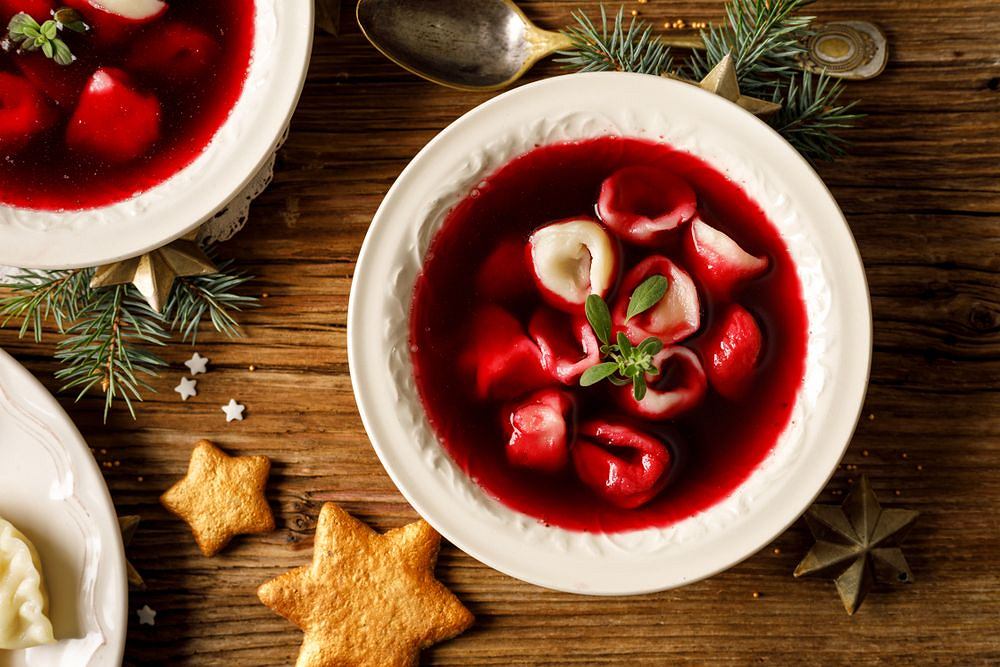
Żurek ranks first in my personal ranking ex aequo with borscht. It is a soup that you must try but its flavor is difficult to describe. It is made from soured rye flour, with traditional Polish sausage, onion, potatoes, and sometimes with egg. You will often come across żurek served in bread.

Kwaśnica is also served in bread. It is a typical dish of mountain cuisine based on sauerkraut and meat, accompanied by potatoes and / or bread.

Rosół - chicken broth is simply a legend and a typical soup eaten on Sundays. It's also great for a hangover and all grandmas will give you a bowl of chicken soup as soon as you feel worse, start catching a slight cold. It is served with thin noodles, carrots and fresh parsley. It is often the base of other soups.

I have already mentioned that in Poland, soups are still very popular: they are healthy, filling and warm in the fall and winter season. They are made with vegetable or meat broth and cannot be missing in any Polish home. In addition to those mentioned above, we have: tomato soup (served with rice or noodles, with cream or not), cucumber (from pickled cucumbers), bean, pea, champignon soup, but also vegetable cream soups like pumpkin soup, mushroom soup and even carrot soup.
SNACKS AND STARTERS
In addition to the aforementioned herrings, cold cuts and sausages, tartare is a typical appetizer but also a good addition to vodka. Made with finely chopped or ground beef, served with salt, pepper, egg yolk, onion, and sometimes finely chopped pickled cucumber is second to none. Often you will also find meat jellies on the Polish table: they can be pork or chicken, with carrots, peas, corn and eggs, all in homemade broth. Let's not forget the lard sandwich - a slice of bread with homemade lard with onion, marjoram, sometimes apples or plums, served with thinly sliced pickled cucumber is a perfect snack and of course... great with vodka.
appetizer but also a good addition to vodka. Made with finely chopped or ground beef, served with salt, pepper, egg yolk, onion, and sometimes finely chopped pickled cucumber is second to none. Often you will also find meat jellies on the Polish table: they can be pork or chicken, with carrots, peas, corn and eggs, all in homemade broth. Let's not forget the lard sandwich - a slice of bread with homemade lard with onion, marjoram, sometimes apples or plums, served with thinly sliced pickled cucumber is a perfect snack and of course... great with vodka.
MAIN COURSES
Polish cuisine has a very distinctive and strong taste, but that doesn't necessarily mean spicy. We prefer well seasoned dishes, we use a lot of garlic, we like onion, chives, dill and parsley, horseradish, marjoram, allspice, bay leaf, mustard and cumin.
Often a typical Polish dinner consists of potatoes or kluski (a cooked dough made of potatoes and flour, similar to Italian gnocci), meat, and vegetables. Often Sunday lunch is a kotlet schabowy (Polish version of pork breaded cutlet) with potatoes and salad (red cabbage, sauerkraut or other) or pickled cucumber. Alternatively, instead of a pork chop on the plate, we will find a minced meat chop (something like larger meatballs prepared from pork or beef), liver, blood sausage or rolada (it is especially present in Silesian cuisine, it is a piece of meat from beef in which a filling is wrapped that often consists of bacon, sausage, onions, mustard, and pickled cucumber). Our favorite vegetables for dinner are sauerkraut (usually prepared with onion and mushrooms); sauerkraut salad with carrots and onions; pickled cucumber; mizeria (grated fresh cucumber, served with salt, pepper and plain yogurt or cream); red cabbage; steamed cauliflower with butter-fried breadcrumbs; beetroot with horseradish or garlic; vegetable salad (it looks like the Spanish ensaladilla rusa). If you can find a good Polish restaurant, be sure to ask for venison.
When describing Polish cuisine, we cannot forget about bigos (a meat and sauerkraut dish, often prepared with leftovers from other dishes), gołąbki (cabbage rolls, baked or stewed, stuffed with rice and groats in tomato sauce) and, of course, pierogi – dumplings similar to Italian tortellini: the dough is made of flour, eggs and some type of fat, and the filling can be different. We can eat pierogi z grzybami (with mushrooms), z kapustą (with cabbage), ruskie (Russian, stuffed with boiled potatoes and cottage cheese), z mięsem (with meat) or sweets, for example, with blueberries. The dumpling are cooked but can be fried later, especially if you eat the leftovers from the day before. We usually serve them with fried onions, or with bacon or sour cream sauce.

BIGOS
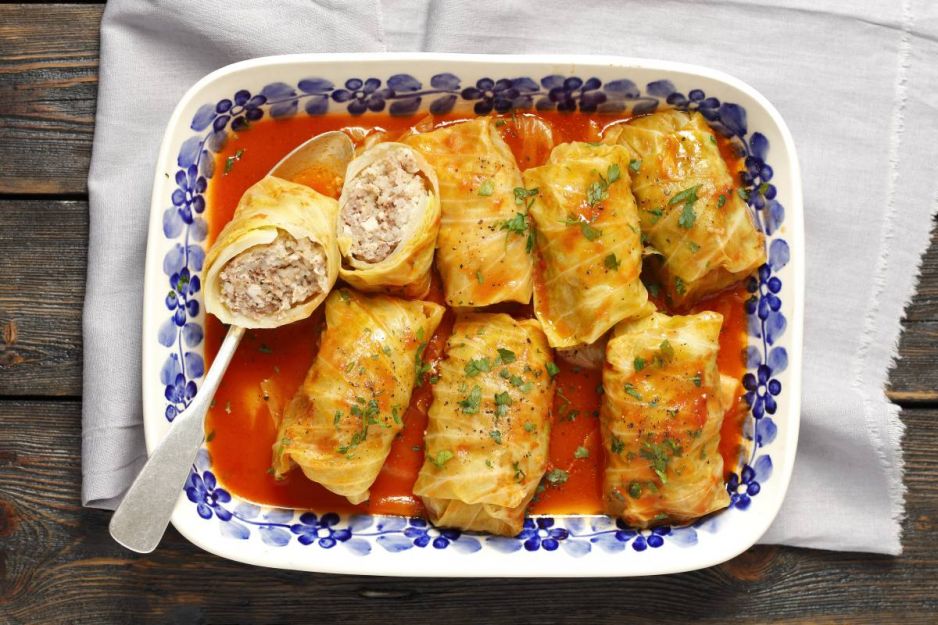
GOŁĄBKI

PIEROGI
Flaki, also consumed in Portugal (where they are called tripas), is a more controversial dish. I'm not a fan myself, this is probably my least favorite Polish dish. Flaki is like a meat stew made from beef stomachs cut into strips with carrots, celery, onion, and parsley root. Golonka, or pork knuckle, is also a popular dish. It must first be marinated very well and then baked with various vegetables. It is a very unhealthy, extremely fatty and extremely caloric dish. The favorite variant of the Poles is the pork knuckle in beer.

DESSERTS
At one point, each self-respecting housewife had at home a cake prepared by herself, which she offered to the guests. Neighbors' gossip was carried out over coffee and a slice of szarlotka (the apple pie, often dusted with powdered sugar and served with a scoop of ice cream), sernik (cheesecake), makowiec (seed pie poppy), piernik (gingerbread) or pączek (a traditional donut). In Poland, you should try pączek with a filling of rose marmalade and faworki (sweet cookies cooked in a very specific way).
GASTRONOMY: MILK BARS vs. KEBAB
In Poland, as in most European countries, we can eat dishes from all over the world; of course, you will find typical chains such as McDonald's, Burger King, KFC, Pizza Hut, TelePizza and many others, but also restaurants serving traditional Polish, Italian, Thai, American, vegan, vegetarian, Indian, sushi ... basically everything your heart desires. You can buy hot dogs in many places (for example, at gas stations or in local Żabka stores), but the real plague is kebab and hamburger places; you will find several of them in all the main streets. The prices are affordable, a dinner for one person can cost from 2.5 EUR and of course there is no upper limit. The cheapest food is served in the bar mleczny (milk bars), a holdover from the communist era. In all major cities, especially around the university, you will find a milk bar serving typical Polish dishes. It is not high quality food and often the dishes are really bland, but they are definitely places loved by students and, above all, they offer prices for all budgets.
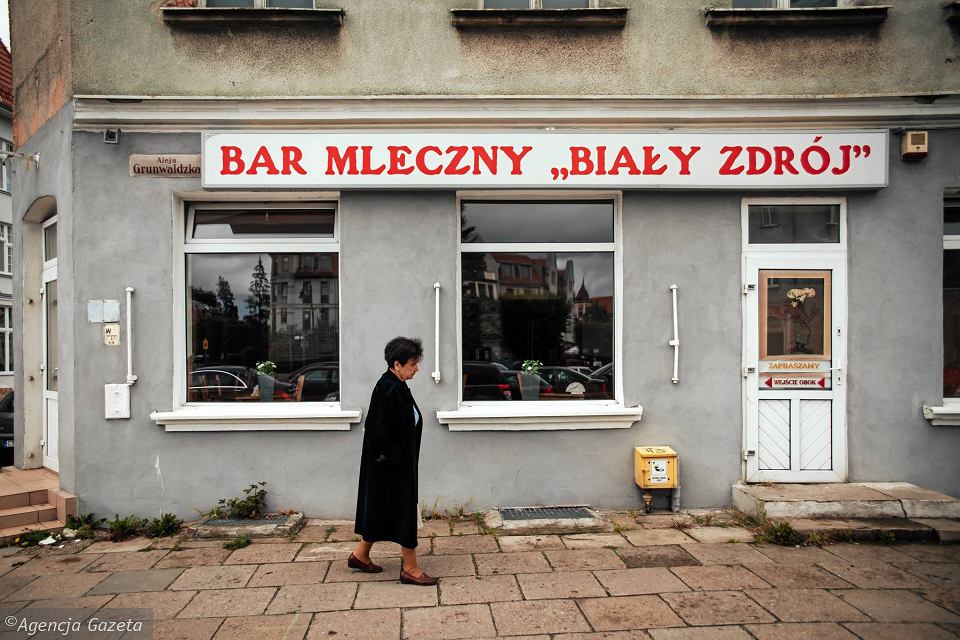
Don't be surprised that we don't smile as much as the Spanish; when we know us better, you will see we are really nice!
ALL PHOTOS IN TODAY'S POST ARE FROM THE INTERNET



